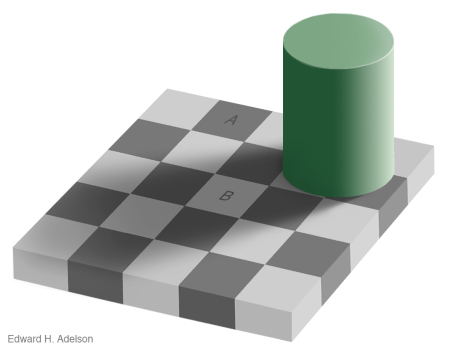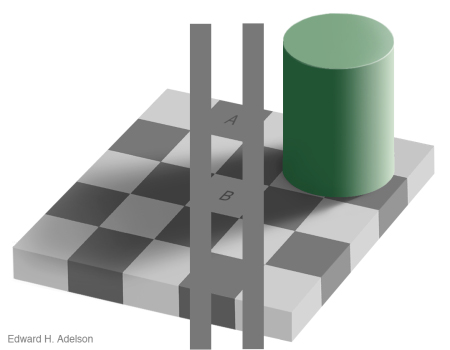
Ian Moore
By understanding these mechanisms we can become sensitized to their shortcomings and so develop approaches to counteract these shortcomings and thus make better decisions.
The way we process information is critical to our decision making. Unfortunately we do not always process this information correctly. We do not always see what is actually there. If we are basing our decisions on correct information which we have processed incorrectly this will obviously lead to faulty decisions.
We tend to see what we expect to see. Have a look at the following diagram. Which square looks darker, A or B?
The vast majority of people think that square B is lighter than square A. However if we draw some uniform grey bars on the diagram we can see that A and B are exactly the same shade.
In the first diagram without the bars we make the assumption that the cylinder is casting a shadow and our brains automatically make the B square appear lighter than it actually is. Now look back to the diagram without the bars on. Even though you know that squares A and B are exactly the same shade B still appears to be lighter.
Here is another example of how we see what we expect to see rather than what is actually there. Try reading the following:
I cnduo’t bvleiee taht I culod aulaclty uesdtannrd waht I was rdnaieg. Unisg the icndeblire pweor of the hmuan mnid, aocdcrnig to rseecrah at Cmabrigde Uinervtisy, it dseno’t mttaer in waht oderr the lterets in a wrod are, the olny irpoamtnt tihng is taht the frsit and lsat ltteer be in the rhgit pclae. The rset can be a taotl mses and you can sitll raed it whoutit a pboerlm. Tihs is bucseae the huamn mnid deos not raed ervey ltteer by istlef, but the wrod as a wlohe. Aaznmig, huh? Yaeh and I awlyas tghhuot slelinpg was ipmorantt! See if yuor fdreins can raed tihs too.
Even though all the words are seriously misspelt we still impose meaning on them. We are not seeing what is actually there but what we would like to see and what we expect to see.
So that is just a couple of examples of how we see what we expect to see rather than what is actually there. In order to make effective decisions we need to see what is actually there not what we expect to see.
If you would like to improve your decision making by seeing what is actually there, try making a list of the ways that you see what you expect in information rather than the actual information. When you have done this you could go through the list and see if you can develop any techniques that would help you see information as it actually is.
There is another way in which information affects our decision making. That is when we have to much information. The next diagram is a simple picture. It is not animated in any way. However when you look at it, it will appear to be moving.
This is a nice example of how too much data causes confusion. Even though the diagram is not moving it still appears to move because of the way our eyes view the picture. If you don’t believe that it is not moving try focusing on one individual spot. You will see that it is not moving but other areas appear to move. Then try to focus on one of the areas that still seems to be moving. It will now appear to be stationery and other areas will appear to move. Or if you focus on the two small red markers on the two top, middle circles, you will see that these circles are stationery.
If you would like to improve your decision making try making a list of the ways that too much data causes problems for your decision making. When you have done this try going through the list and see if you can devise techniques that would help.
Ian Moore runs workshops and gives presentations on how people and organisations can improve their Decision Making by understanding how they make poor ones. For more information see: www.unthinkablethinking.com or email Ian at ian@unthinkablethinking.com


